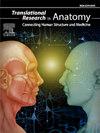在印度人群中使用三维计算机断层扫描对肩胛骨上切迹和肩胛骨上角进行形态学评估
Q3 Medicine
引用次数: 0
摘要
背景在肩胛骨解剖的各个方面中,肩胛骨上切迹受到了关注,因为其解剖变异是该区域肩胛上神经受压的一个易感因素,可能会对骨科手术产生影响。本研究旨在调查肩胛上切迹(SSN)的形态及其随年龄和性别畸形的变化。方法对 180 名成人的 360 例肩胛骨计算机断层扫描进行了回顾性分析。根据 Rengachary 的分类(I-VI 型)对 SSN 的形态进行了分类,并测量了 SSN 的最大深度(MD)和最大宽度(MW)。根据形态特征对肩胛骨上角进行了分类。结果I型SSN最常见,表明肩胛上神经卡压的易感性较低。男性的 MD 明显高于女性。两侧肩胛骨的 SSN 类型和上角相同,但两侧也有差异,这在统计学上有显著意义。年龄差异不明显。肩胛骨上角分为四种类型:丘陵型、山峰型、新月型和烟囱型,其中丘陵型最为常见。结论这些发现可为准确诊断相关异常以及在肩胛骨上区进行安全有效的内窥镜和开放手术提供必要的全面了解。本文章由计算机程序翻译,如有差异,请以英文原文为准。
Morphometric evaluation of suprascapular notch and superior angle of the scapula using three-dimensional computed tomography in the Indian population
Background
Among the various aspects of scapular anatomy, the suprascapular notch has gained attention as its anatomical variation is a predisposing factor for compression of the suprascapular nerve in this region, potentially impacting orthopedic surgery. This study aims to investigate the morphology of suprascapular notch (SSN) and its variation with age and sexual dimorphism. It also seeks to classify and correlate the superior angle of the scapula with the SSN in the Indian population.
Methods
A retrospective analysis of 360 computed tomography scans of scapulae of 180 adults was conducted. The morphology of SSN was classified according to Rengachary's classification (types I-VI), and the maximum depth (MD) and maximum width (MW) of SSN were measured. The superior angle of the scapula was classified based on morphological characteristics.
Results
Type I SSN was the most prevalent, suggesting lower susceptibility to suprascapular nerve entrapment. Males had significantly greater MD than females. Identical types of SSN and superior angles on both sides of the scapula were statistically significant, though variations on each side were also observed. There was no significant difference in age. The superior angle of the scapula was classified into four types: Hilly, mountain peak, crescent, and chimney, with the hilly type being the most common. No correlation was found between SSN and the superior angle.
Conclusion
These findings may provide a comprehensive understanding necessary for accurate diagnoses of related abnormalities and for performing safe and effective endoscopic and open surgical procedures in the suprascapular region.
求助全文
通过发布文献求助,成功后即可免费获取论文全文。
去求助
来源期刊

Translational Research in Anatomy
Medicine-Anatomy
CiteScore
2.90
自引率
0.00%
发文量
71
审稿时长
25 days
期刊介绍:
Translational Research in Anatomy is an international peer-reviewed and open access journal that publishes high-quality original papers. Focusing on translational research, the journal aims to disseminate the knowledge that is gained in the basic science of anatomy and to apply it to the diagnosis and treatment of human pathology in order to improve individual patient well-being. Topics published in Translational Research in Anatomy include anatomy in all of its aspects, especially those that have application to other scientific disciplines including the health sciences: • gross anatomy • neuroanatomy • histology • immunohistochemistry • comparative anatomy • embryology • molecular biology • microscopic anatomy • forensics • imaging/radiology • medical education Priority will be given to studies that clearly articulate their relevance to the broader aspects of anatomy and how they can impact patient care.Strengthening the ties between morphological research and medicine will foster collaboration between anatomists and physicians. Therefore, Translational Research in Anatomy will serve as a platform for communication and understanding between the disciplines of anatomy and medicine and will aid in the dissemination of anatomical research. The journal accepts the following article types: 1. Review articles 2. Original research papers 3. New state-of-the-art methods of research in the field of anatomy including imaging, dissection methods, medical devices and quantitation 4. Education papers (teaching technologies/methods in medical education in anatomy) 5. Commentaries 6. Letters to the Editor 7. Selected conference papers 8. Case Reports
 求助内容:
求助内容: 应助结果提醒方式:
应助结果提醒方式:


